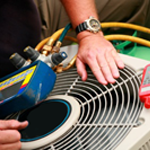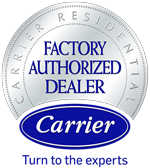Preventive Maintenance

With regular maintenance you will prevent small problems from becoming big problems and ensure optimal performance of your comfort system. We also offer annual service agreements, which can reduce the cost of a Performance Tune-Up.
Regular maintenance will:
- Provide longer lasting equipment
- Reduce utility bills
- Reduce repairs
- Provide a more comfortable indoor environment
- Protect your investment
ROUTINE MAINTENANCE – Performed By Owner
Simple, routine maintenance as described below will enhance your system’s ability to operate economically and dependably.
WARNING
ELECTRICAL SHOCK HAZARD
Failure to follow this warning could result in personal injury or death.
Disconnect all electrical power to the indoor air handler or furnace
Before removing access panels to perform any maintenance.
Disconnect power to both the indoor and outdoor units.
NOTE: There may be more than one electrical disconnect switch.
Keep Filter Clean
A clogged or improperly installed air filter on your indoor unit will increase operating costs and shorten the life of the unit. For detailed filter cleaning information refer to indoor unit literature.
Do Not Block Floor, Wall or Ceiling Vents
When drapes, furniture, toys or other common household items block vents, the restricted airflow lessens the system’s efficiency and life span.
Do Not Cover or Block Outdoor Unit
The outdoor unit needs unrestricted airflow. Do not cover it or place items on or next to it. Do not allow grass clippings, leaves, or other debris to accumulate on the sides or top of the unit. And, maintain a 12” minimum clearance between the outdoor unit and tall grass, vines, shrubs, etc.
Check Condensate Drain
Your air conditioner removes humidity from your home during the cooling season. After a few minutes of operation, water should trickle from the condensate drain of the indoor coil. Check this occasionally to be sure the drain system is not clogged. Drainage will be limited if you live in a very dry environment.
Do Not Operate Below 55°F/12.78°C
Your outdoor unit is not designed to operate when outdoor temperatures are lower than 55°F/12.78°C without modification. If operation below this temperature is required, consult your Carrier dealer.
Coil Cleaning
Your indoor coil is located in a sealed cabinet on your indoor unit and will require minimal cleaning with routine filter maintenance. Longer operating cycles and reduced energy efficiency may indicate the need for a coil cleaning by your Carrier dealer.
Base Pan Drainage
Periodically check for and remove debris that has settled around the base of your outdoor unit. This will ensure proper drainage of the base pan and eliminate standing water inside the outdoor unit.
Level Installation
Your Carrier dealer will install the outdoor unit in a level position. If the support base settles or shifts and the unit is no longer level, be sure to re-level it promptly to assure proper drainage. If you notice water or or ice collecting beneath the unit, arrange for it to be drained away from the unit.
Performance Furnace Tune-Up
- Test for carbon monoxide leaks
- Clean burner assembly
- Clean ignition assembly
- Clean blower motor
- Inspect filtration system
- Adjust blower components
- Lubricate moving parts as required
- Test and adjust safety controls
- Tighten electrical connections
- Calibrate thermostat
- Check flue draft
- Check combustion
- Inspect vent piping
- Inspect humidification system
Performance Air Conditioner Tune-Up
- Clean condenser coil
- Inspect evaporator coil if accessible
- Clean condensate drain
- Clean blower motor
- Inspect filtration system
- Adjust blower components
- Lubricate moving parts as required
- Inspect for refrigerant leaks
- Test condensate pump
- Tighten electrical connections
- Test starting capabilities
- Measure air temperature differential
- Monitor refrigerant pressure
- Measure amperage and voltage
Performance Air Handler Tune-Up
- Inspect evaporator coil
- Clean blower motor
- Inspect filtration system
- Adjust blower components
- Lubricate moving parts as required
- Test and adjust safety controls
- Tighten electrical connections
- Calibrate thermostat
- Inspect humidification system
- Inspect electrical heating elements
Performance Heat Pump Tune-Up
- Clean condenser coil
- Clean condensate drain
- Check defrost controls
- Inspect auxiliary heaters
- Inspect filtration system
- Lubricate moving parts as required
- Inspect for refrigerant leaks
- Test condensate pump
- Tighten electrical connections
- Test starting capabilities
- Measure air temperature differential
- Monitor refrigerant pressure
- Measure amperage and voltage










